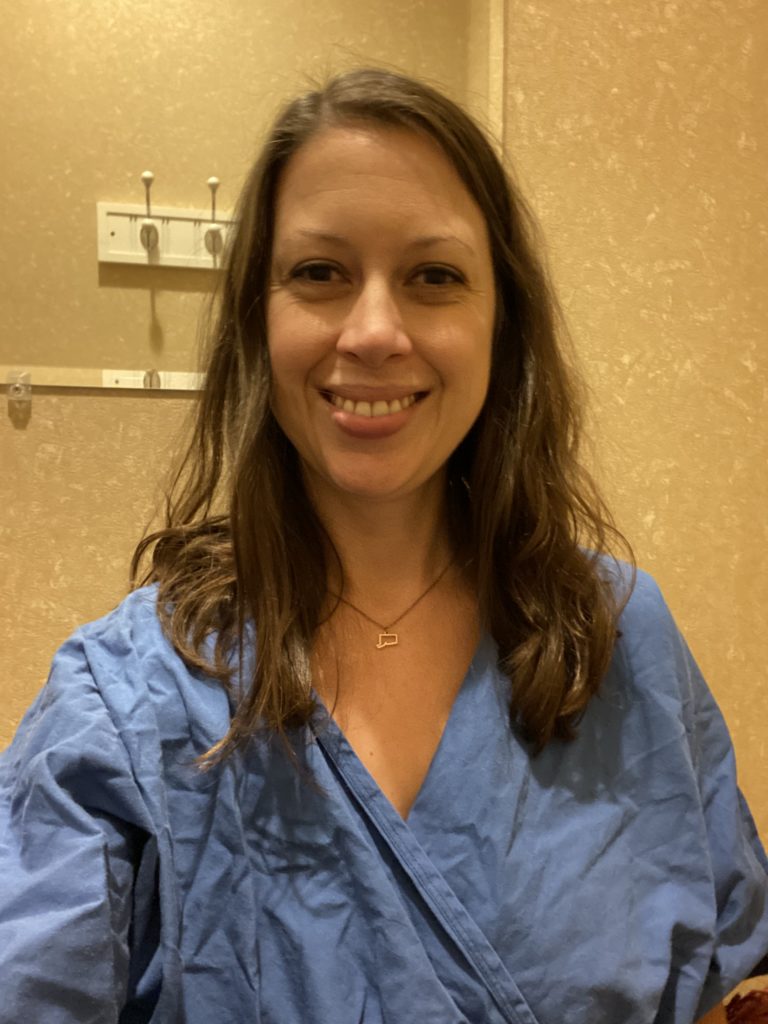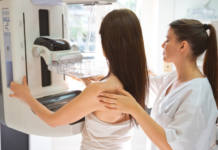The first time my gynecologist suggested I get a baseline mammogram, I smiled and said I’d look into it. I didn’t. I had no idea what to expect from a mammogram and I wasn’t ready to find out.
There is a history of breast cancer on both sides of my family tree, which puts me at higher risk. A baseline would serve as a comparison for all future mammograms. When my doctor brought up the topic at my next appointment, I told her I would call to see if my insurance would cover it. I never called.
I’m a healthy 38-year-old woman. I see a gynecologist and a primary care physician annually, as well as an endocrinologist every six months. I go once a year to the optometrist, twice to the dentist, and get screened by the dermatologist every other year. When a hair stylist told me I should get a trim every six to eight weeks, I nearly burst out laughing. Right. In all my spare time.
And let’s not forget, I’m a mom of a small child and an even smaller dog. I bring my son to the pediatrician at least once a year and biannually to the dentist. My pup has to make two trips the vet each year for vaccines because he’s too small to get all of his shots at once. On top of all this, I’m expected to schedule an appointment to have some sadistic technician flatten my breasts into pancakes once a year?
It’s not that I don’t understand the risks.
It’s likely that someone you know has been affected by breast cancer. As I mentioned, I have a family history myself. I also have a friend, several years younger than I am, who spent half of 2018 undergoing chemotherapy. Her hair fell out. She wasn’t able to lift her toddler. She may not be able to have more children. I mentioned that my doctor had recommended the baseline mammogram and my friend told me, emphatically, to just do it. She explained that the BRCA 1 and BRCA 2 mutations were only discovered in relatively recent history. Even though my parents were tested, there could still be a genetic contributor to the breast cancer in my family.
Point blank: I didn’t want to get the test done.
I knew I’d have to submit to my fears eventually, but I thought I had more time to procrastinate. While I’m certainly staring down the barrel of 40, I’m not there yet. I wasn’t worried about the results; it was more of an overall anxiety about the procedure. I didn’t know what to expect. When I Googled “What does a mammogram feel like?” I found dozens of vague, unhelpful descriptions that blandly informed me that the test was “uncomfortable.”
I like to be prepared and I’m anxious when I’m not. If you’re the same way, I don’t want that anxiety to stop you from getting screened. So…
Here’s what you can expect (more or less).
The Internet has plenty of advice to offer. Schedule your appointment for the week after your period when your breasts are less tender. Avoid caffeine the day of. Take some ibuprofen beforehand to minimize pain. I choose to do all three–why risk it?
When I made my appointment at Advanced Radiology in Fairfield, they asked me to come in fifteen minutes early to fill out paperwork. I was told not to wear any deodorant or powders, which may mess with the imaging, so I arrived on time, nervous about what to expect and probably smelling of body odor.
The technician led me to the changing room and handed me a top to change into. Pro-tip: you only need to strip from the waist up, so don’t wear a dress. Comfortable shoes are also assets.
The mammogram consisted of four images in total, two of each breast.
Before taking the pictures the tech gently moved my arms, head, and body into place. For the first two images, each breast (one at a time) was positioned on the shelf of the machine and a clear, plastic plate slowly came down from above. At first I could just feel a small amount of pressure and the sensation of my skin stretching slightly.
The tech brought the plate down to what she called an “8” and told me we were going to “15.” Before proceeding, she asked if I was okay. I was. I was actually perfectly fine. It didn’t feel like much at all, except for the odd sensation of having your breast propped up on a shelf. As she moved the plate further down, I felt an increase in pressure and slight compression on the top and bottom of my breast. The most accurate description I had read compared the squeezing sensation to getting your blood pressure taken. It was a similar sensation to the cuff getting tighter around your arm.
For the second images, the top plate tilted to a forty-five degree angle. The technician warned that I might feel discomfort where the plate pressed against my chest above my breast. She asked me to hold my breath and keep my stomach still for a few seconds during these images to reduce any movement. Again, she reminded me to tell her if I was in pain. This was the only part of the procedure that I would say hurt, but it was over in a matter of seconds. It felt like someone pressing a blunt object hard against your rib cage, just north of your breast. If you’ve given birth, you’ve felt pain far beyond this and it’s over in half the time of your mildest contraction.
And then it was done.
The technician showed me the images afterwards and warned me not to be worried if I’m called to come back for an ultrasound. It’s harder to detect cancer in dense tissue found in premenopausal women. I had some redness on my chest from the plates, but it went away quickly and there was no soreness. The whole experience took about forty minutes from when I walked in the door to when I was fully dressed and on my way out.
Of course, this was my personal experience.
There are different factors that may make your mammogram more or less painful. The size and density of your breasts, the type of machine, and even the technician could be a factor. I don’t know if the advice I took from the Internet made a difference, but it didn’t hurt. A heads up: I had read about having stickers put over your nipples to help identify them on the image. This wasn’t part of my experience but don’t be weirded out if it’s part of yours.
Don’t procrastinate. Now that you know what to expect from a mammogram, you have no excuse. A family member told me that had she missed just one year, she may not have caught her cancer in time. It’s not worth the risk.




























